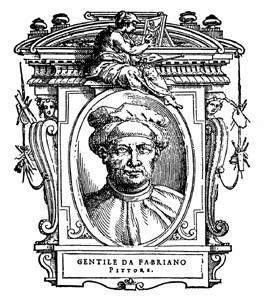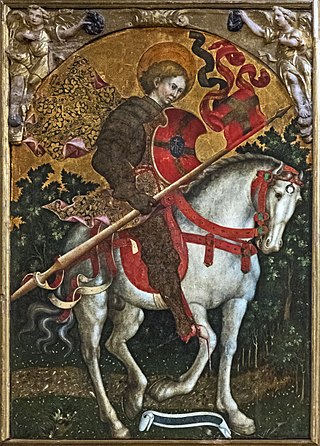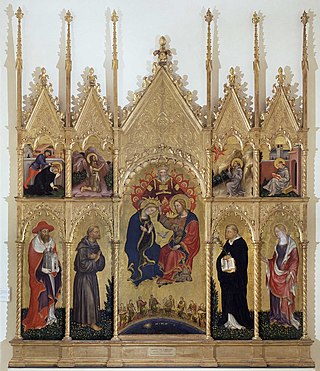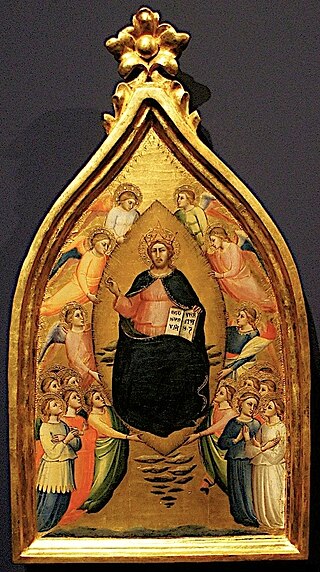
Fra Angelico, OP was a Dominican friar and Italian painter of the Early Renaissance, described by Giorgio Vasari in his Lives of the Artists as having "a rare and perfect talent". He earned his reputation primarily for the series of frescoes he made for his own friary, San Marco, in Florence, then worked in Rome and other cities. All his known work is of religious subjects.

Gentile da Fabriano was an Italian painter known for his participation in the International Gothic painter style. He worked in various places in central Italy, mostly in Tuscany.

Giovanni di Paolo di Grazia was an Italian painter, working primarily in Siena, becoming a prolific painter and illustrator of manuscripts, including Dante's texts. He was one of the most important painters of the 15th century Sienese School. His early works show the influence of earlier Sienese masters, but his later style was more individual, characterized by cold, harsh colours and elongated forms. His style also took on the influence of International Gothic artists such as Gentile da Fabriano. Many of his works have an unusual dreamlike atmosphere, such as the surrealistic Miracle of St. Nicholas of Tolentino painted about 1455 and now housed in the Philadelphia Museum of Art, while his last works, particularly Last Judgment, Heaven, and Hell from about 1465 and Assumption painted in 1475, both at Pinacoteca Nazionale (Siena), are grotesque treatments of their lofty subjects. Giovanni's reputation declined after his death but was revived in the 20th century.

The Adoration of the Magi is a painting by the Italian painter Gentile da Fabriano. The work, housed in the Uffizi Gallery in Florence, Italy, is considered his finest work, and has been described as "the culminating work of International Gothic painting".

Michele Taddeo di Giovanni Bono, known as Giambono was an Italian painter, whose work reflected the International Gothic style with a Venetian influence. He designed the mosaics of the Birth of the Virgin and Presentation in the Temple. His best known paintings are the Man of Sorrows and the St. Peter.

Jacobello del Fiore was a Venetian painter in the late fourteenth century and early fifteenth century. His early work is in the Late Gothic style popularized by Altichiero da Verona and Jacopo Avanzi, two of his contemporaries, while his mature work displays a local Venetian style established by the school of Paolo Veneziano, an artist and workshop proprietor with notable Byzantine inspiration in his work. This stylistic return to his roots sets him apart from Niccolò di Pietro and Zanino di Pietro, Venetian contemporaries he is often associated with. During his lifetime, he received commissions primarily on the Adriatic coast and in Venice.
The decade of the 1420s in art involved some significant events.

The Coronation of the Virgin or Coronation of Mary is a subject in Christian art, especially popular in Italy in the 13th to 15th centuries, but continuing in popularity until the 18th century and beyond. Christ, sometimes accompanied by God the Father and the Holy Spirit in the form of a dove, places a crown on the head of Mary as Queen of Heaven. In early versions the setting is a Heaven imagined as an earthly court, staffed by saints and angels; in later versions Heaven is more often seen as in the sky, with the figures seated on clouds. The subject is also notable as one where the whole Christian Trinity is often shown together, sometimes in unusual ways. Crowned Virgins are also seen in Eastern Orthodox Christian icons, specifically in the Russian Orthodox church after the 18th century. Mary is sometimes shown, in both Eastern and Western Christian art, being crowned by one or two angels, but this is considered a different subject.

Michelino Molinari da Besozzo was a notable fifteenth century Italian painter and illuminator, who was widely praised for his work. He worked mostly in Milan and Lombardy, and was employed by the Visconti family, rulers of Milan. Michelino's work follows the traditions of the Lombard School, and maintains the Trecento style.

The Valle Romita Polyptych is a painting by the Italian late Gothic painter Gentile da Fabriano, dating from c. 1410-1412 and now housed in the Pinacoteca di Brera in Milan. It was originally executed for the Franciscan hermitage of Valle Romita near Gentile's birthplace, Fabriano.

Mariotto di Nardo di Cione was a Florentine painter in the Florentine Gothic style. He worked at the Duomo of Florence, the church of Santa Maria Maggiore, and the Orsanmichele. He created both frescoes and panel paintings, and was also active as a manuscript illuminator.

The Madonna of Humility is a tempera-on-panel painting by the Italian late medieval artist Gentile da Fabriano, dating from around 1420-1423 and housed in the Museo nazionale di San Matteo, Pisa.

The Adoration of the Christ Child is a tempera and gold on panel painting by the Italian late medieval artist Gentile da Fabriano, dating from around 1420–1421 and housed in the Getty Center of Los Angeles, United States.
The Master of Staffolo was an anonymous late-Gothic style painter active in the region of Marche and Umbria.

Madonna and Child is a tempera on panel painting of the enthroned Madonna and Child by Gentile da Fabriano. At its base are small angel musicians. It is now in the Galleria Nazionale dell'Umbria in Perugia.

Saint Francis Receiving the Stigmata is an oil and tempera painting by Gentile da Fabriano, executed c. 1420, now in the Magnani-Rocca Foundation in the Province of Parma in Italy. It is the back of a processional banner - the front showing the Coronation of the Virgin is now in the Getty Center in Los Angeles.

Madonna and Child is a tempera and gold on panel painting by Gentile da Fabriano, executed c. 1420–1423, now in the National Gallery of Art in Washington, D.C. The work is generally identified as one of the first the artist produced in Florence, where he had arrived in summer 1420, at roughly the point at which he was working on the Pala Strozzi. It may have been the central panel of a polyptych, the rest of which is now lost.

Madonna and Child with Saints Julian and Lawrence is a c. 1423–1425 tempera and gold leaf on panel painting by Gentile da Fabriano. It is now in the Frick Collection in New York. To the left is saint Lawrence in a deacon's dalmatic and holding the gridiron of his martyrdom, whilst to the right is Saint Julian.

The Intercession Altarpiece is a five-panel tempera and gold on panel painting by Gentile da Fabriano, produced during his stay in Florence from 1420 to 1423. Its original location is unknown, though it is now in the sacristy of Chiesa di San Niccolò Oltrarno in Florence. It is named after its central panel of Jesus and the Virgin Mary interceding to God the Father. The two outermost panels show Louis of Toulouse and Bernard of Clairvaux. The two inner side-panels show the Resurrection of Lazarus and a group of three saints.

















